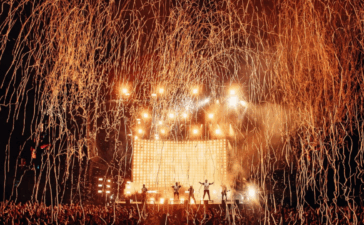At the turn of the first decade of the 21st century, Linkin Park were firmly established as the world’s number one stadium rock act. The previous ten years had seen an astonishing ascendancy from the band, who had ridden the wave of late ’90s alternative nu metal and zine culture, combined those tropes with icy pop hooks and radio-friendly song structures plus a splash of Y2K paranoia, and single-handedly sent rap/metal supernova.
Of course, many critics will point out that it was a case of right-place-right-time, bolstered by a healthy dose of industry manipulation and with results only achieved due to the groundwork done by the likes of Korn, Limp Bizkit, Mudvayne, Deftones and a smattering of other eyebrow-studded, glow-in-the-dark guitar-wielding MTV favourites.
However, as easy as it potentially was to explain away the success of their chart-topping debut Hybrid Theory, darker and more hip-hop influenced follow-up Meteora firmly asserted Linkin Park’s place at the top of the metal cohort that had planted themselves behind mainstream lines. And then came a collaboration with Jay-Z, followed quickly by a partnership with the Transformers franchise to herald in the arrival of their third album in the years since 2000, Minutes To Midnight.
As the saying goes: Fool me once, shame on you. Fool me twice, shame on me. Fool me three times, shame on both of us. While Minutes To Midnight certainly leaned more into broader pop influences (see: ‘Shadow of the Day’) it also capitalised on Linkin Park’s metal chops (‘No More Sorrow’, ‘Given Up’) while delivering their critical masterstroke in the form of a short, sharp single that upgraded them from arenas to football stadiums worldwide (‘Bleed It Out’).
Even Rolling Stone, who had panned their groundbreaking debut, came to the party here, noting on Minutes to Midnight: “Rap metal is dead. Linkin Park are not, because they were always more than the meager sum of that combination.” This statement would ring true on August 2nd, 2010 when the band ventured into the new decade, a world where social media now ruled the roost, and announced their new incarnation with ‘The Catalyst’, the lead single from their fourth LP A Thousand Suns.
On the title alone, it appeared that this would be the band’s heaviest work yet – referencing the Hindu holy text Bhagavad Gita, the title was taken from infamous nuclear scientist J. Robert Oppenheimer, who described 1945’s atomic bomb as being “as bright as a thousand suns.”
An album dealing with nuclear warfare and human apocalypse sounded appropriately on-brand for a band that had dabbled with dystopian futuristic themes on previous releases, and so it was a complex kind of shock when ‘The Catalyst’ varied from the curve, presenting itself not as a skatepark metal crossover anthem, but a tech-heavy epic, seemingly taking more sonic cues from Swedish House Mafia than Drowning Pool.
For those who found the change hard to digest, bassist Dave ‘Phoenix’ Farrell signalled doomsday, warning listeners that “we’ve known [the album was] going to be different, and if fans were expecting Hybrid Theory or Meteora, they’re going to be surprised. It’s going to take people some time to figure it out and know what to do with it.”
11 years on, and it would appear that Farrell was correct. Listening back to A Thousand Suns with a critical ear and more open mind, it’s clear that it wasn’t just the “experimental album” that so many legacy acts tick off. It turned out to be the record that proved that Linkin Park belonged in the upper echelons of songwriting, production, and conceptual composition, regardless of genre.
For a start, the hooks that helped sell that mythical first trio of records are turned up to eleven here. From the joyous stomp of ‘Waiting for the End’ to the post-fallout reflection of ‘Iridescent’, and arguably Bennington’s finest vocal performance on record with ‘The Messenger’, this is LP writing at its most pristine.
But it’s with the production and conjuring up a sense of atmosphere that things become truly breathtaking. Interludes abound tying these songs together as one 45 minute sci-fi trip – the album even begins with two back-to-back interludes, making Tool’s 10,000 Days look boorishly conventional – with a sense of wonder and beauty mixing with deep sadness as the record plays out across choice cuts ‘Burning In The Skies’ and ‘Robot Boy’.
Whether it be taking in the scope of disaster from afar, or being hurled into the eye of the uncertain, increasingly deadly storm (‘When They Come For Me’, ‘Wretches and Kings’), A Thousand Suns places the listener firmly in a world of Linkin Park’s own making, with the pump-up gym junkie jams of old traded for a deeper and more conceptual experience.
This was their Kid A moment, an abandonment of everything that defined the outfit, a move that somehow resulted in what sounded like the truest version of themselves to date. But there is a caveat, which is that while they did enter new territory, nothing on A Thousand Suns should have dramatically surprised a listener acquainted with their back catalogue (aside from the distinct lack of rhythm guitar on many tracks).
From the get-go, Linkin Park had been on a deconstructionist journey. This was first seen starkly on the brilliant Reanimation album, which contained a bunch of Hybrid Theory remixes that were so good some replaced the originals in their live set (see: ‘P5hng Me A*wy‘). This continued on the B-side of Meteora, with super-hit ‘Breaking the Habit’ actually beautifully foreshadowing the coming tapestry of A Thousand Suns, while ‘Nobody’s Listening’ and ‘Numb’ continued to work at showcasing their skill at mixing aggressive rap with melancholic melody.
What set A Thousand Suns apart, however, was the fact that its sound barely reflected what was popular on mainstream charts at the time. Hybrid Theory and Meteora came as nu metal reigned supreme, while Minutes To Midnight proved a meatier take (in parts) on the chart-topping formulas of acts like The Fray, The Script and Coldplay.
A Thousand Suns rather is the sound of a band who have made peace with their incredible success, and are kicking off a fresh decade of existence by making the music they want to hear – record sales and ticket numbers be damned. It marked the beginning of a decade of experimentation for the band that both thrilled us (The Hunting Party), intrigued us (Living Things) and downright shocked us (the ever divisive but no less genius One More Light).
Ultimately it was the beginning of a road that would end in heartbreak, with Chester Bennington’s tragic passing in 2017 sending shockwaves through all levels of the music industry, both mainstream and underground.
But upon casting back, it’s clear that by the turn of the next decade, no one could level the accusation against Linkin Park that they were trend hoppers. A Thousand Suns put that claim to the sword, and in doing so captured a band leaving expectations in the dust and walking steadfastly towards the void.










